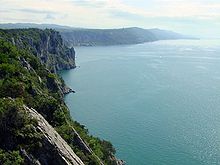Duino
Duino | |
|---|---|
 Duino Castle | |
| Coordinates:45°46′29″N13°36′22″E/ 45.77472°N 13.60611°E | |
| Country | Italy |
| Region | Friuli-Venezia Giulia |
| Comune | Duino-Aurisina |
| Elevation | 39 m (128 ft) |
| Population (2001) | |
| • Total | 1,421 |
| Demonym | Duinesi or Duinati |
| Time zone | UTC+1(CET) |
| • Summer (DST) | UTC+2(CEST) |
| Postal code | 349011 |
| Dialing code | 040 |
Duino(Slovene:Devin,German:Tybein) is today aseaside resorton the northernAdriaticcoast. It is ahamletofDuino-Aurisina,a municipality (comune) of theFriuli–Venezia Giuliaregion of northeasternItaly.The settlement, picturesquely situated on the steepKarstcliffs of theGulf of Trieste,is known forDuino Castle,immortalized by the poetRainer Maria Rilkein hisDuino Elegies.
Name
[edit]Duino was attested in historical sources asDuinoin 1139,Dewinin the 13th century, andTybeinc.1370, among various other forms of the name. Although equivalents of the Slovene name appear in various Slavic languages (cf.SlovakDevín,PolishDziewin,etc., all ultimately derived from Slavic*děva'girl'), the name of this settlement is not originally Slavic. Instead, it derives fromRomancetubīnum< Latintubus'(water) pipe'.[1][2]
History
[edit]
The Lords of Duino,vassalsof thePatriarchs of Aquileia,were first mentioned about 1150. From their ancestral seat, located on a rock high above the Adriatic Sea, they controlled the trade routes running from the city ofMonfalconealong the coast to theIstrianpeninsula. Serving asministerialesof theCounts of Goriziaand also of their successors, theHabsburgarchdukes ofInner Austria,they secured their position in theFriuliregion.[citation needed]
Their Old Castle is today in ruins, while the newer Duino Castle, dating back to 1389, is inhabited to this day and can be visited by tourists. Below the ruins of the ancient castle there lies a white rock projecting into the sea, theDama Bianca,which resembles a veiled woman and gave origin to many gothic legends. Held by the descendants of theDella Torre(Thurn) noble family from the 16th century onwards, the estates were inherited by Marie von Thurn und Taxis (1855–1934) in 1893.[citation needed]A patron of the arts and socialite, she accommodated Rainer Maria Rilke at Duino Castle from 1911 to 1912 and he dedicated hisDuino Elegiesto her. By the late 19th century, Duino with its scenic views andMediterranean climatehad become a fashionable seaside resort on theAustrian Riviera.[citation needed]Notable guests included EmperorFranz Joseph I of AustriaandEmpress Elisabeth,ArchdukeMaximilian I,his consortCharlotte,and ArchdukeFranz Ferdinand,as well asEleonora Duse,Franz Liszt,Gabriele D'Annunzio,Paul Valéry,Mark Twain,andVictor Hugo.

AfterWorld War Iand the dissolution of theAustro-HungarianEmpire, Duino became part of theKingdom of Italy.It was merged into the municipality of Duino-Aurisina in 1928.[citation needed]
Until the 1950s, Duino was a predominantlySlovene-speaking village with a sizeableItalian-speaking minority. According to the last Austrian census of 1910, 63.5% of the inhabitants of the town wereSlovenesand 25.1% wereItalians(the rest were either German speakers or foreign citizens).[3]The Italian census of 1921 confirmed the Slovene ethnic character of the town, and even showed an increase of the proportion of Slovene speaking population to 78.4% (mostly as the result of the emigration of Austrians and Germans residing in the town).[4]During the years of theFree Territory of Trieste(1947–1954), however, its ethnic composition changed considerably, as manyIstrian Italiansfleeing from Yugoslaviasettled in Duino.
Today, Duino is a predominantly Italian-speaking town, with a Slovene-speaking minority. Most signs are written in both languages, and the municipality of Duino-Aurisina is an officially bilingual one. Since 1982 the village has been home toUnited World College of the Adriatic,an international school attended by students from over 80 countries, and one of 18UWCsaround the world.[5]
Notable people
[edit]Duino is noted for being the place where the physicistLudwig Boltzmanncommitted suicide in 1906. It is also the place where the well-knownSlovenefolk legendLepa Vidatakes place.[6]
See also
[edit]References
[edit]- ^Snoj, Marko (2009).Etimološki slovar slovenskih zemljepisnih imen.Ljubljana: Modrijan. p. 109.
- ^Franco Crevatin (1976). "Il nome di Duino". In Corbato, Carlo (ed.).Studi Monfalconesi e Duinati Atti della giornata di studio di Monfalcone, 3. aprile 1976(Antichità altoadriatiche 10).Udine: Arti grafiche friulane. pp. 23–27.RetrievedJanuary 6,2019.
- ^Spezialortsrepertorium der österreichischen Länder: Österreich-illyrisch. Küstenland(in German). Vol. 7. K. K. Hof- u. Staatsdr. 1918.
- ^Oko Trsta(Belgrade: DIZ, 1945), 157
- ^"Two new Colleges join UWC | UWC".Archived fromthe originalon 29 October 2014.Retrieved29 October2014.
- ^"Devin - na skrajnem severu Sredozemlja - Kam.si".10 January 2008.

